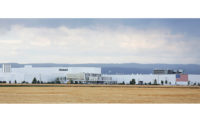

Short-lived because of ethanol and pigs in China and a drought in Australia and the arrival of common sense in the European Union and a host of other events converging on the milk market in the United States.
But first, a look at the good news. It all began about a decade ago. That’s when the rubber hit the road, when after decades of muddling around a few folks started taking milk seriously.
That’s when Scottie Mayfield and associates rolled out milk in single-serve, plastic, re-closable bottles. That’s when Scottie got the attention of Howard Dean. That’s when Howard sunk a pile of money into Chugs. That’s when Wall Street pounded his stock price lower.
It was the beginning of making the dairy case much more attractive. The bland, white wall was slowly, but surely turned into a collection of bright colors and stylish shapes and suitable sizes and tasty flavors.
It was the beginning of making milk much more readily available to consumers; not just in the dairy case. Milk became portable. Milk fit in a “cup holder.”
MilkPEP stepped up and while it is lauded for elevating consumer awareness; its greater success is probably making dairy processors and milk marketers more aware of their own potential-more aware of the options and opportunities in the milk business.
Both MilkPEP and Dairy Management Inc. have made customers-fast food chains and school cafeteria operators to name a couple-more aware of the potential gains by serving ice cold milk.
At the same time, messages from farmer- and processor-funded efforts have started to gain traction with Mr. and Mrs. John Q. Public and their offspring. Aging Baby Boomers seem to be a little more health conscious than previous generations. It’s a lot less expensive to stay well than to recover from illness. Broken bones, diabetes and obesity are preventable.
With a new level of awareness about health and nutrition, enter organics. Albeit a small base, sales of organic milk have been racking up an annual increase of 20% or more for most of the past decade. Recombinant bovine somatotropin (rBST) posed a speed bump to growth, but recently a surge in retailer requests have begun to fill a void. Milk from cows not treated is populating dairy cases everywhere.
Controversies surrounding the broad-based introduction of milk from cows not treated with rBST threatened to derail the sales of conventional milk. But that apparently hasn’t happened. During the height of the debate, milk sales increased 2% versus year-earlier levels. This may, in fact, be a modern-day record increase in sales.
It is a sales record, however, that will probably be short-lived. As I draft this document, milk prices are marching toward record high levels.
Why? Very low farm milk prices for the past two years have put a lid on production growth. Ethanol production and oil prices have driven production and processing costs sharply higher. And customers from around the world have beaten a path to the USA for dairy proteins.
All of the great efforts-packaging, positioning, promoting-may be for naught. Milk prices are significantly higher and they have risen quickly-a double-edged sword. An antiquated pricing system, namely federal milk marketing orders, which link the price of beverage milk to the prices of cheese, butter, nonfat dry milk and whey, deserves some of the blame.
It’s too late to fix the system now, but we certainly ought to give serious thought to some alternatives sooner rather than later. Most organic milk leaves the farm per the terms of a negotiated, fixed price; a long-term contract. Can we do the same for conventional milk? Can we bring at least some stability to beverage milk prices?
For archived Jerry Dryer articles visitwww.dairyfoods.com.








